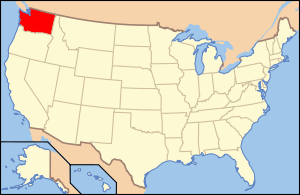Pickett House (Bellingham, Washington)
|
Pickett House | |
|
| |
 | |
| Location | Bellingham, Washington |
|---|---|
| Coordinates | 48°45′22″N 122°29′08″W / 48.75611°N 122.48556°WCoordinates: 48°45′22″N 122°29′08″W / 48.75611°N 122.48556°W |
| Built | 1856 |
| NRHP Reference # | 71000881[1] |
| Added to NRHP | December 13, 1971 |
The Pickett House is the oldest house in the city of Bellingham, Washington, located on 910 Bancroft Street. Built in 1856 by United States Army Captain George Pickett, who later became a prominent general in the Confederate States Army during the Civil War, the house was listed on the National Register of Historic Places in 1971.[2]
History
After Captain Pickett arrived in Bellingham on the pretense of overseeing the construction Fort Bellingham, he chose a spot on what was then called Peabody Hill in the town of Whatcom to be cleared for his home. The house was built with two stories of lumber provided by the nearby Roeder-Peabody lumber mill on Whatcom Creek. About a year later, the Captain's son, James Tilton Pickett, was born in the house. After Pickett left Bellingham in 1861 to serve in the Civil War, the house changed hands several times, before Hattie Strothers left the house to the Washington State Historical Society in 1936 upon her death. In 1941, the home became a museum, and later home to the Daughters of Pioneers, both of which still occupy the site.[3][4]
Very few changes have been made to the original structure. A narrow staircase was added to replace the ladder leading to the upstairs sleeping quarters, and a kitchen has been added to the lean-to section of the house.
Gallery
 Facade of the Pickett House with sign on 910 Bancroft Street, Bellingham, WA.
Facade of the Pickett House with sign on 910 Bancroft Street, Bellingham, WA. Plaque at the front of the Pickett House
Plaque at the front of the Pickett House Photo of the Pickett House showing the lean-to section
Photo of the Pickett House showing the lean-to section Chair and rug detail from inside the Pickett House
Chair and rug detail from inside the Pickett House Interior of the Pickett House showing a sofa chair and windows looking out to the front
Interior of the Pickett House showing a sofa chair and windows looking out to the front Interior of the Pickett House showing the organ and a rocking chair
Interior of the Pickett House showing the organ and a rocking chair
References
- ↑ National Park Service (2007-01-23). "National Register Information System". National Register of Historic Places. National Park Service.
- ↑ National Register of Historical Places - WASHINGTON (WA), Whatcom County
- ↑ George E. Pickett House (1856) 910 Bancroft Street - City of Belligham, WA
- ↑ Edson, Lelah Jackson. The Fourth Corner: Highlights From the Early Northwest. Bellingham, Washington, Whatcom Museum of History and Art, 1968, pp. 58-60.

